Exclusive: Canadian Gov’t Database Reveals Catastrophic Reproductive Damage to Men and Women


Overview
An analysis of January 2015 through December 2022 data extracts from the Ontario Health Insurance Plan (OHIP) database exposes a myriad of reproduction-related harms to Ontarians following the rollout of COVID-19 vaccines in Canada. This dataset includes about six million unique patients. Importantly, it contains four years of ‘baseline’ data from before COVID-19 or COVID-19 vaccines showed up in Canada, as well as data from the 2020, when only COVID-19 the disease was present, and the ‘COVID vaccine years’ of 2021 and 2022. This gives us a window into the health changes Ontarians experienced following the introduction COVID vaccines, of which over eight-five percent of Ontario residents took two doses by March 30, 2022. About fifty percent of people in Ontario received a third “booster” dose by that same date. Therefore, the data reflects a very highly vaccinated population and the fallout from those vaccinations.
This analysis reviews data, obtained by Freedom of Information requests, associated with nine of the OHIP Diagnostic (a.k.a., Billing) Codes:

For all of these reproductive categories, patients given these diagnostic codes at least doubled from 2020, when COVID vaccines were not yet available, to 2021 and 2022, when the vast majority of Ontarians received at least two doses of COVID-19 vaccines.
Healthcare professionals working in outpatient settings use OHIP billing/diagnostic codes to submit claims to the Ontario Health Insurance Program. Since Canada has socialized medicine, residents must go to a primary care doctor first to be referred to a specialist. Insurance claims for those patient visits have to be submitted via Ontario’s medical claims electronic transfer. So, with rare exception, these data represent all Ontarians’ non-emergency healthcare diagnoses for the years 2015 to 2022.
Reproductive Harms Findings – 2021-2022 Versus 2020
In reviewing the 2015 to 2022 OHIP patient counts data, Amy Kelly found the following for 2021-2022, the years in which Ontarians received COVID vaccines. Canadian medical professionals assigned:
- OHIP Code 634 — Orchitis (inflammation of the testicles)/Epididymitis (inflammation of the epididymis, a curved structure at the back of the testicle) — to 31,557 distinct patients. That equals more than double the patients who received this diagnostic code in 2020 – i.e., prior to the vaccines’ rollout.
- OHIP Code 606 — Male Infertility, Oligospermia (low sperm count), Azoospermia (absence of sperm in semen) — to 65,392 unique patients. This equates to more than twice as many patients receiving this diagnostic code versus in 2020, prior to the vaccines’ rollout.
- OHIP Code 614 — Acute OR Chronic Salpingitis (infection causing inflammation in the fallopian tubes), Oophoritis (inflammation of the ovaries), or Abscess, Pelvic Inflammatory Disease — to 15,043 distinct patients, more than twice as many unique patients than received that diagnostic code in 2020 when the vaccines were not yet available.
- OHIP Code 626 — Disorders of Menstruation — to 837,425 distinct patients, over 2.25 times the number who received this diagnostic code in the pre-COVID vaccines year of 2020.
- OHIP Code 627 — Menopause, Post-Menopausal Bleeding — to 387,741 unique patients, more than 2.5 times those coded to 627 in 2020 before COVID vaccines were publicly available.
- OHIP Code 628 — Infertility — to 224,900 distinct patients, almost 2.3 times greater than the number of patients coded to that diagnostic code in 2020.
- OHIP Code 629 — Other Disorders of the Female Genital Organs — to 227,242 unique patients, more than 2.5 times the number times this code was given to patients in 2020.
- OHIP Code 632 — Missed Abortion (a.k.a., a missed miscarriage or spontaneous abortion; a miscarriage in which the fetus did not form or is no longer developing, but the placenta and embryonic tissues are still in the mother’s uterus) — to 30,430 distinct patients, more than two times the patients assigned this code in 2020.
- OHIP Code 634 — Incomplete Abortion, Complete Abortion (incomplete abortion is when some products are held back in the uterus after a miscarriage; a complete abortion is when products of conception have passed and the cervix is closed) — to 44,929 unique patients, more than twice as many patients who received this diagnostic code before COVID vaccines in 2020.
The Data
You may access the datasets:
- FOI for Ontario OHIP codes – Female Repro Health & Related – PATIENT COUNTS – Data 2015-2022.
- FOI for Ontario OHIP codes – Female Repro Health & Related – INCIDENCE – Data 2015-2022.
The information entered into the OHIP claims system, from which this data was extracted, is entered by humans and, thus, should be viewed with chance of human error occurring. For example, a medical coder may accidentally transpose a number in a diagnostic code and, thus, enter the incorrect code into the system. No quality control is performed to catch such errors. However, once may assume that approximately the same amount of human error occurs over time, so the data accuracy remains fairly constant over time.
Additionally, in looking at the data, one sees that males listed in diagnostic codes associated with women’s health, and women listed in diagnostic codes associated with men’s health. In Ontario, citizens “…have the right to change [their] gender marker and name on all…identity documents. This may include…Health Card (OHIP: Ontario Health Insurance Plan).” [https://www.wrcls.ca/name-change-gender-marker-change/] Therefore, one may assume that the mix of “Sex Type Codes” in the OHIP data is due to patients’ gender identities, rather than gender at birth, being recorded or, possibly, data entry errors.
Analysis of Data from Patient Counts Dataset
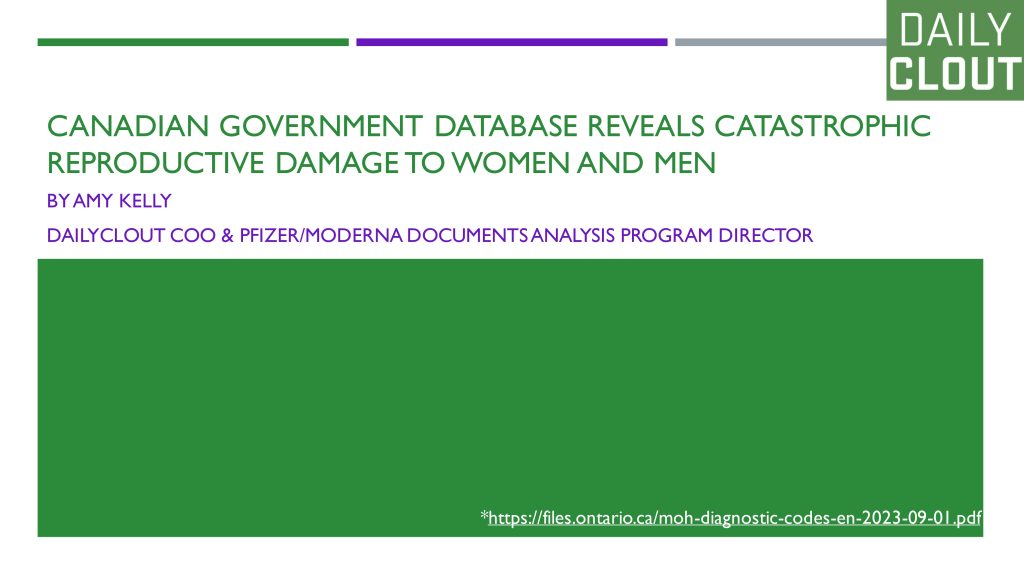
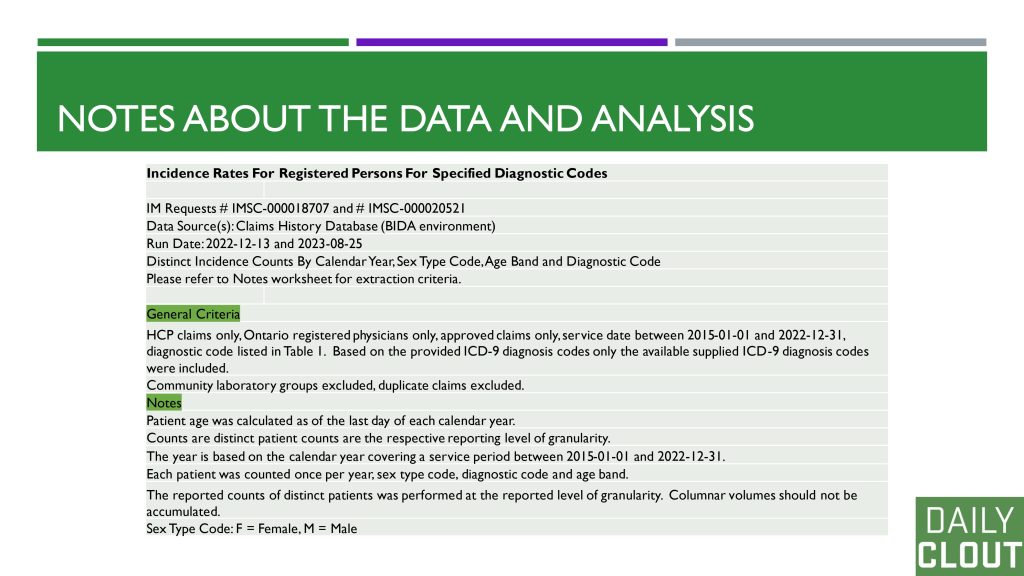
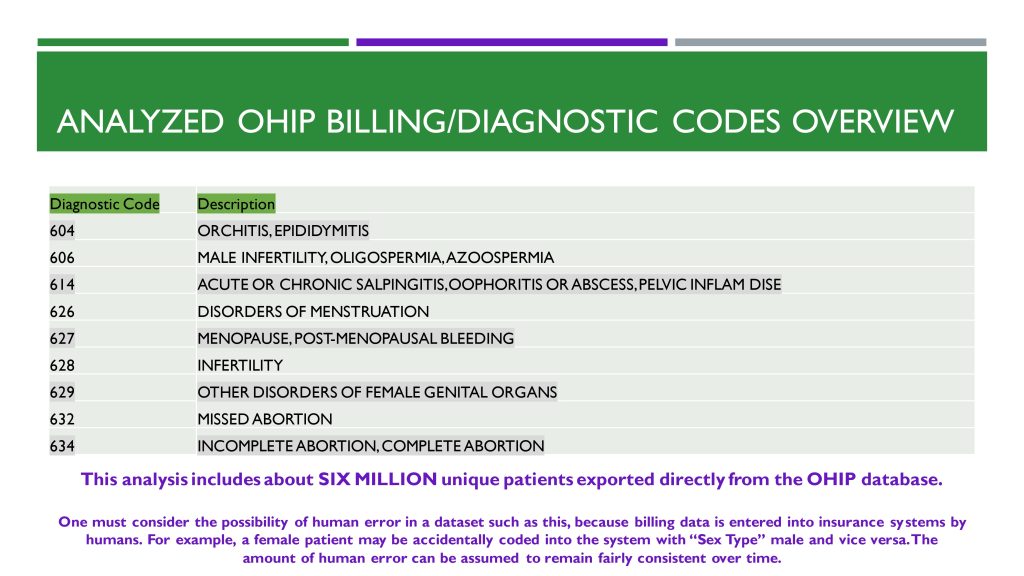

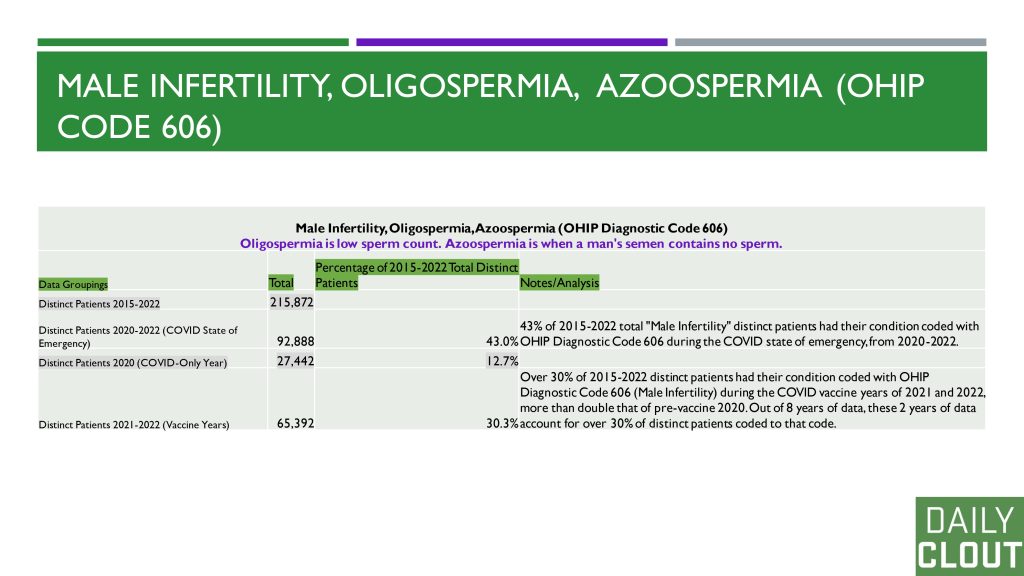
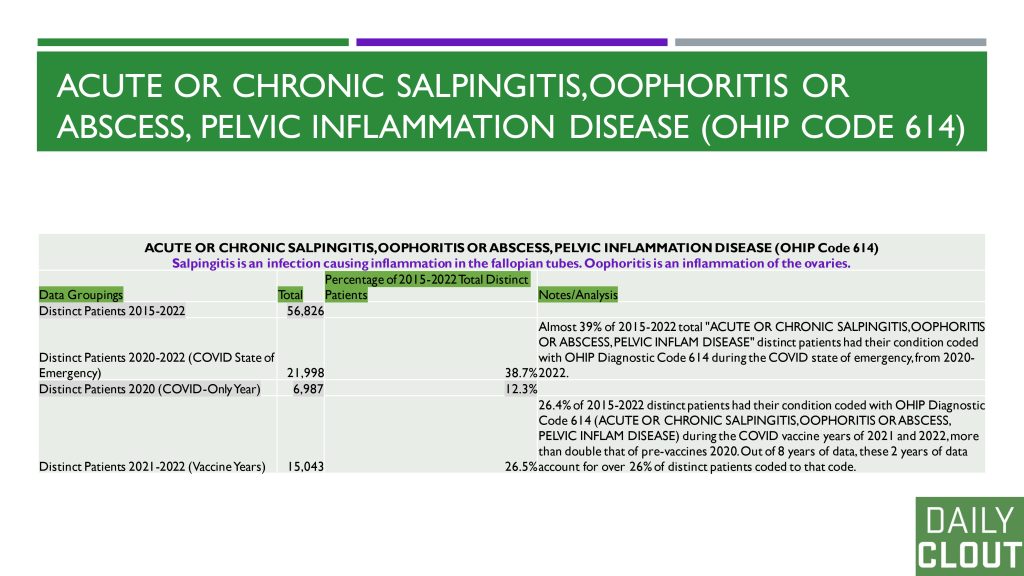
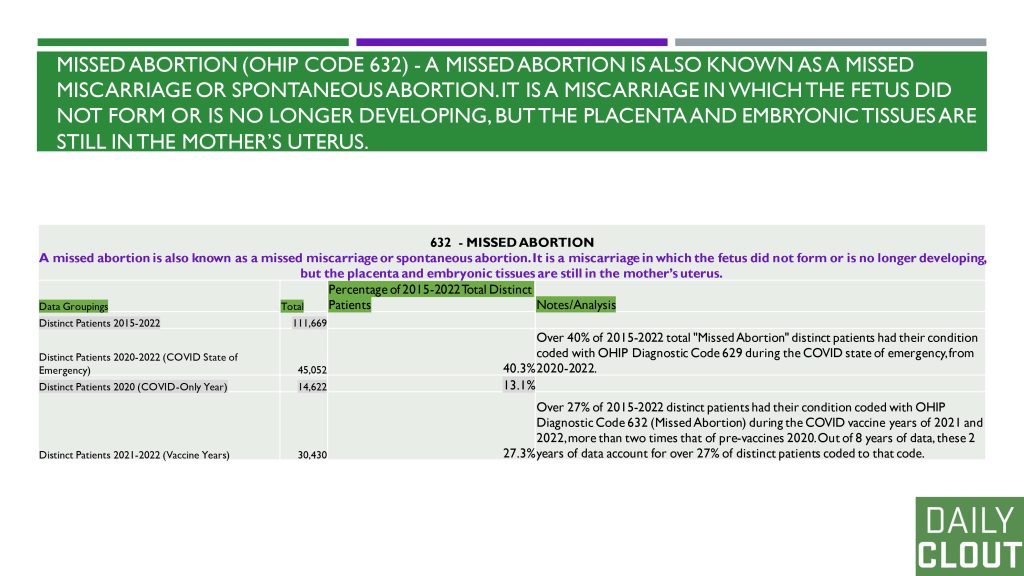
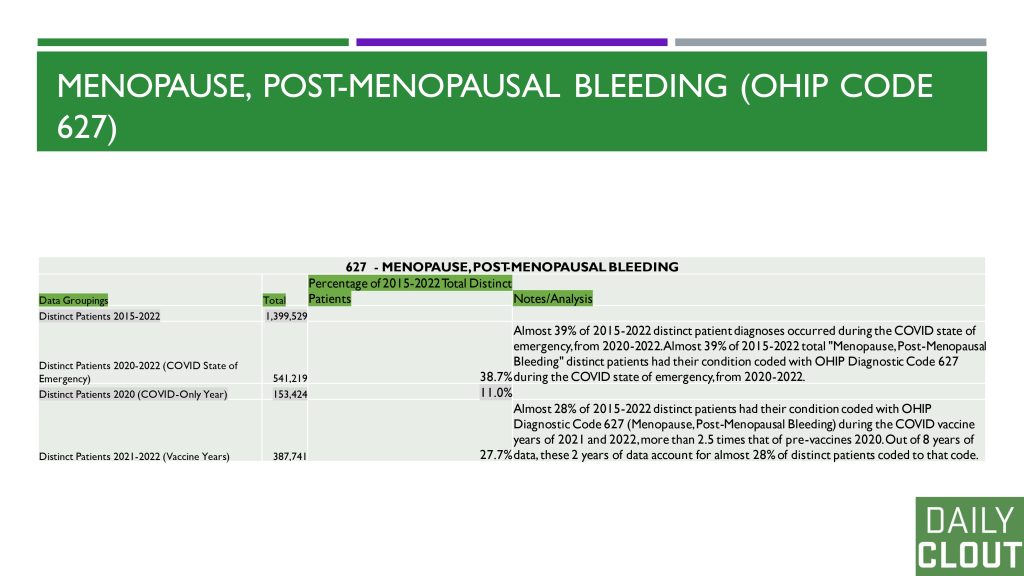

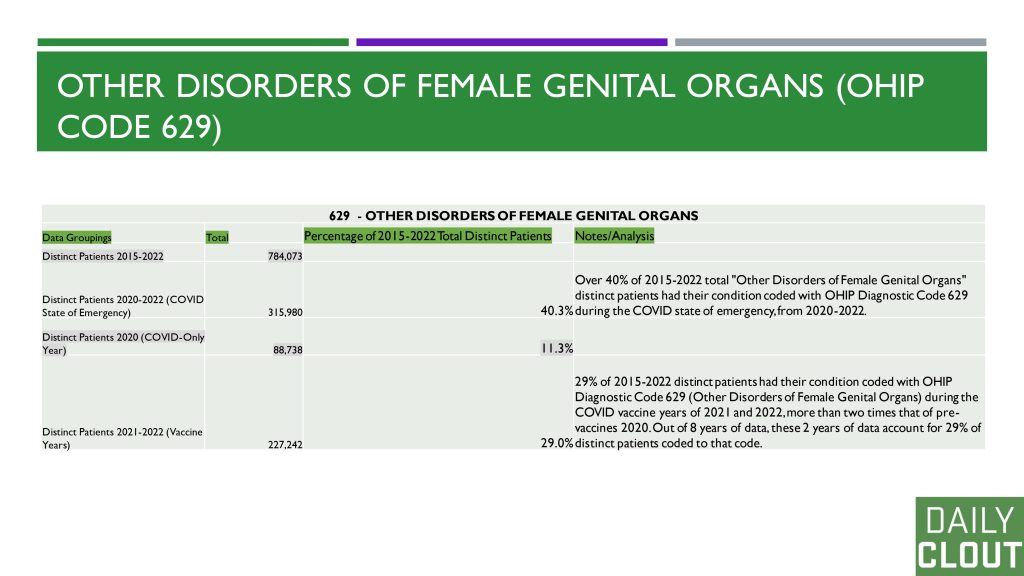

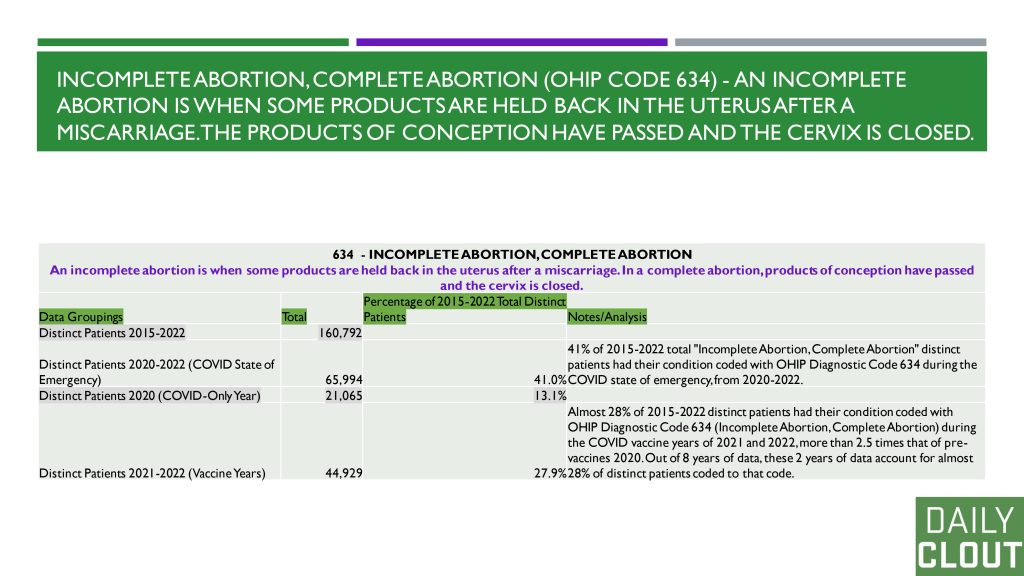
Download the PDF of this presentation.
These data leave no doubt that COVID vaccines negatively impacted the reproductive health of Ontarians. The Canadian government still encourages its citizens to receive COVID vaccine boosters, so the vaccine-related harms are sadly ongoing. This smoking gun must be used to hold Health Canada and the Canadian and provincial governments, all of which mandated COVID vaccination to take part in many basic life activities, accountable for how its citizens have been harmed.
Pre-Order The Pfizer Papers.
Donate to DailyClout.
Become a DailyClout Member.





Thank you for your work but this seems misleading. Look at code 604 for example. There is a steady 15k-17k distinct patients per year. Obviously the two “vaccine years” are double that of the one covid year. Also, the two vaccine years are roughly 1/4 the total for all 8 years as expected. In general, 2020 saw lower diagnosis counts overall due to people staying home and not going to the doctor. Probably best to look at pre-covid versus post-covid.
Thank you for your comment and feedback. I’ll add additional context to the post after some more analysis. While fewer patients went in person to see medical professionals in 2020, there were a lot of telemed visits in 2020; and those are included in the data. I plan to implement your suggestion of comparing pre-COVID to post-COVID. Again, thank you.
I couldn’t find the bar charts that Naomi showed on her phone. The tables here looked like they would require a lot of work to figure out what was being described.
What would be even better would be line charts, showing the data for each available year.
Thank you for doing this.
Hi David,
The charts can be found here: https://dailyclout.io/canadian-govt-database-reveals-catastrophic-reproductive-damage-to-men-and-women-post-mrna-vaccine-rollout/.